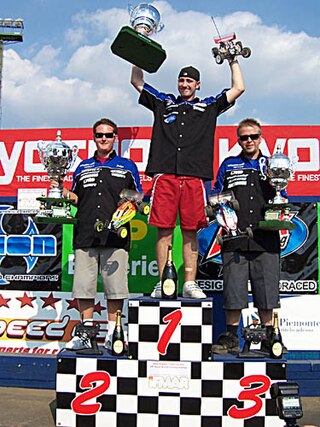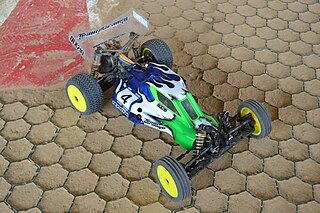Related Research Articles
Radio-controlled cars, or RC cars for short, are miniature model cars, vans, buses, trucks or buggies that can be controlled from a distance using a specialized transmitter or remote. The term "RC" has been used to mean both "remote controlled" and "radio-controlled". "Remote controlled" includes vehicles that are controlled by radio waves, infrared waves or a physical wire connection. RC cars are powered by one of three energy sources—electricity, nitro fuel or petrol. Electric RC models are powered by small but powerful electric motors and rechargeable nickel-cadmium (Ni-Cd), nickel metal hydride(NiMH), or lithium polymer (LiPo) cells with the latter two being the most used. Both NiMH and LiPo have advantages and disadvantages in various RC applications where NiMH is mainly used for recreational purposes and LiPo for more demanding purposes. There are also brushed or brushless electric motors—brushless motors are more powerful, long lasting and efficient, but also much more expensive than brushed motors.

Royal Air Force Elvington or more simply RAF Elvington is a former Royal Air Force station which operated from the beginning of the Second World War until 1992 located at Elvington, Yorkshire, England. It is now the location of the Yorkshire Air Museum.

The International Federation of Model Auto Racing (IFMAR) is the world governing body of professional radio controlled car racing.
Remotely Operated Auto Racers, abbreviated as ROAR, is the sanctioning body of competitive radio-controlled car racing in the United States and Canada. It is a US national non profit organization that promotes the sport of radio controlled model car racing.
Associated Electrics, Incorporated of Lake Forest, California, is one of the world's leading manufacturers of radio controlled cars, trucks and accessories. Associated Electrics is now owned by Thunder Tiger Corporation from Taiwan. The company is usually referred to as Team Associated.
Masami Hirosaka is a Japanese radio controlled car driver who is considered to be the world's most successful with a record fourteen IFMAR World Championships in 1/12 scale electric, 1/10 scale Pan, 1/10 scale 2WD off-road and 1/10 scale 4WD, all electric. Hirosaka's peers have nicknamed him "Master Masami". He was considered to be one of the highest paid drivers in RC racing, until he retired from the activity. His last IFMAR race was the 2008 world championship in Thailand. His retirement ceremony was on May 3, 2009.

Mallory Park is a motor racing circuit situated in the village of Kirkby Mallory, just off the A47, between Leicester and Hinckley, in central England. Originally used for grass-track until 1955, a new, basically oval hard-surfaced course was constructed for 1956, with a later extension forming a loop with a hairpin bend.
The IFMAR World Championship for 1:10th Electric Off-Road Cars is a world championship radio controlled car race sanctioned by the International Federation of Model Auto Racing (IFMAR). It takes place biennially on odd years since 1987 in its current format but inaugurated in 1985 as a championship for Stock and Modified class It is considered by the radio-controlled modelling industry to be the most prestigious event in the calendar that a number of mainstream hobby and toy brands have fielded factory entries.

A 1:10 radio-controlled off-road buggy is a 1:10 scale radio-controlled dune buggy designed for off-road racing. These cars are based on their full-scale equivalents that are commonly found in desert racing. The buggies are split into two race categories, two (2WD) and four-wheel drive (4WD). These can easily be distinguished visually by their wheel size at the front. Cars are typically electric powered, but nitro versions do exist but are less common because racing classes exist for electric cars. The class is inexpensive and similar to a number of other classes, and this makes them popular with newcomers. The cars are also known as 1/10 off-road.
Sanwa Denshi, widely known as Sanwa, is a brand of wireless equipment best known for its high end radio-control gear for scale modelling use. The company have been a subsidiary of the SMC Group since 1965 and began to diversify into the manufacturing of radio-control equipment in 1974 and remote control devices for home and industrial use since 1985.
2009 IFMAR 1:10 scale Electric Off-Road World Championships was the 13th running of the IFMAR 1:10 Electric Off-Road World Championship for 1:10 radio-controlled electric off-road buggies sanctioned by the International Federation of Model Auto Racing (IFMAR) that ran over two separate classes.
Jared Randall Tebo is an American radio-controlled car racer from Raymore, Missouri who specializes in off-road racing driving for Mayako.
The 2007 IFMAR 1:10 Electric Off-Road World Championship was the 12th edition of the biennial IFMAR 1:10 Electric Off-Road World Championship for 1:10 scale radio-controlled electric off-road buggies sanctioned by the International Federation of Model Auto Racing (IFMAR) to be run over two classes over seven days between 9 and 16 September 2007. Each class ran for three days.

Nic Case is an American radio-controlled model hobbyist from Southern California specializing in speedrunning. He is notable for becoming the first person to reach 200 mph (321.9 km/h) with his radio-controlled car, the R/C Bullet, having surpassed his records three times with a confirmed entry at the Guinness World Records in 2008, 2013 and 2014. His attempt has been documented by the Discovery Channel and was cited in an episode of Tosh.0.
1989 IFMAR 1:10 Electric Off-Road World Championships was the third edition of the 1:10 Electric Off-Road World Championship that took place in Australia at the St Ives Showground in Sydney between 4 and 10 September 1989.
The 1991 IFMAR 1:10 Electric Off-Road World Championships was the fourth edition of the IFMAR 1:10 Electric Off-Road World Championship was held in United States in the city of Detroit from 4–11 August. The host club was SEMROCC Racing with the tracks location in Freedom Hill Park in the Sterling Heights area of the city. A large entry of over 120 drivers attended the event., October 1991
The sixth IFMAR - 1:10 Electric Off-Road World Championship was held in Japan at the Yatabe Arena in Tsukuba City.
The 1997 IFMAR 1:10 Electric Off-Road World Championship was the 7th edition of the biennial IFMAR 1:10 Electric Off-Road World Championship for 1:10 scale radio-controlled electric off-road buggies sanctioned by the International Federation of Model Auto Racing (IFMAR) to be run over two classes over seven days between 9 and 16 August 1997 with each class ran for three days.
The 1987 IFMAR/Parma 1:10 Electric Off-Road World Championship was the second edition of the IFMAR 1:10 Electric Off-Road World Championship that was held on the at now defunct Romsey Club which was based on the cite of the Malthouse Inn in Timsbury, Hampshire, near Southampton on the Central South Coast of England.
The fifth IFMAR - 1:10 Electric Off-Road World Championship was held in Basildon in Essex.The 2wd class had a popular win being won by Brian Kinwald from America racing an Associated RC10. Gene Husting of Associated described how the track was deteriorating every day and how team order were implemented for the 3rd final race "Brian's the only one who has a chance to win. He's starting in 6th position. He needs to win this round. If he comes up on you, give him plenty of room to pass. You are, of course, free to race everyone else on the track.". The 4WD was won by Masami Hirosaka of JPN racing a Yokomo there were strong showing for the two home British driver racing Schumacher Cat cars the brand with which Masami won his first title in 1987.
References
- 1 2 3 4 5 Hyndman, Carl (January 2016). "Cliff Lett on the RC10 and Radio Control, Then and Now". Radio Control Car Action. Air Age Media: 73–74. Archived from the original on 2015-12-22.
- 1 2 "Top 10". Radio Control Car Action. Air Age Media: 56. May 1993.
- 1 2 3 4 Arita, Derek (November 1989). "Interview: Cliff Lett". Radio Control Model Cars. Retrieved 27 January 2016.
- 1 2 3 4 Masi, Frank (November 1991). "Car Action Interview: Cliff Lett". Radio Control Car Action. Air Age Media: 129–132.
- 1 2 "Ten Best R/C Drivers". Radio Control Car Action. Air Age Media: 51. May 1989.
- ↑ "RC10Talk.com - View topic - Podcast with Cliff regarding "Stealth"" . Retrieved 1 January 2016.
- ↑ "Inside Story on the RC10". TeamAssociated.com. Retrieved 15 January 2016.
- ↑ Chaplin, Keith (October 1991). "1991 1/10 Off-Road World Championships". Radio Race Car. Malvern, Worcestershire: Traplet Publications. Retrieved 22 November 2015.
- ↑ Blandin, Christophe (November 1991). "Come Back to Detroit". Auto 8 (in French). Paris: Editions Larivière: 72.
- ↑ Delapierre, David (1991). "Hirosaka: Les Deux Poles et Champion en 4x2!" [Hirosaka: The Two Poles and Champion of 4x2](PDF). RCM (in French). Paris: Editions Loisirs Techniques.
- ↑ Husting, Gene (1991). "1991 Off-Road IFMAR World". Radio Control Model Cars. Retrieved 22 November 2015.
- ↑ Pond, Steve (December 1991). "1991 IFMAR World Champs". Radio Control Car Action. Wilton, Connecticut: Air Age Media.
- 1 2 3 4 5 Gonzalez, George M. (May 2001). "The Need for Speed: Behind the scenes at Associated's "Guinness Book" speed record attempt". Radio Control Car Action. Air Age Media: 129. Retrieved 1 January 2016.
- 1 2 3 Jeffrey M. O'Brien (1 March 2003). "Speed Demons". WIRED. Retrieved 4 January 2016.
- 1 2 "FLASHBACK FRIDAY: Cliff Lett sets Guinness World Record for Fastest RC Car". LiveRC.com. Retrieved 1 January 2016.
- ↑ Folkard, Claire (1 August 2002). Guinness World Records 2003 . Guinness World Records Limited. p. 141. ISBN 9781892051172.
- ↑ "World Record! Nic Case Breaks the 200mph Barrier". RC Car Action. Archived from the original on 6 December 2016. Retrieved 1 January 2016.
- ↑ Pond, Steve (November 1990). "Masami's Yokomo". Radio Control Car Action . Wilton, Connecticut: Air Age Media: 56.
- ↑ "MY MOTOCROSS INSPIRATIONS BY RICK JOHNSON". Motocross Action Magazine. Retrieved 2 January 2016.
- 1 2 David, Wally (December 1989). "1989 ROAR Off-Road Nationals". Radio Control Car Action. Air Age Media . Retrieved 1 January 2016.
- 1 2 Husting, Gene (November 1989). "1989 ROAR Offroad Championship". Radio Control Model Cars. Retrieved 1 January 2016.
- ↑ Lee, Mike (December 1990). "ROAR Off-Road Nats". Radio Control Car Action. Air Age Media: 100–106.